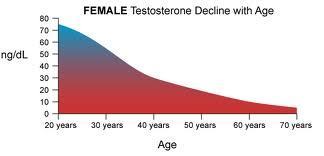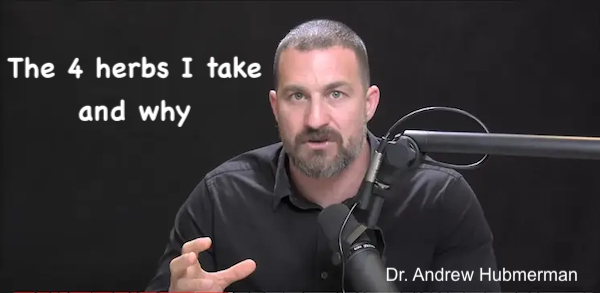Effective Herbs for Exercise and Stress, says Dr. Huberman

Two herbs that can reduce stress, one of which can improve exercise performance, plus two that boost testosterone. Watch Dr. Andrew Huberman explain why he uses them.
In an interview with Tim Ferriss, Dr. Andrew Huberman explains why he takes these four herbs:
- Ashwagandha for stress and sleep
- Rhodiola Rosea for exercise enhancement
- Indonesian Tongkat Ali for libido and testosterone
- Fadogia agrestis for testosterone
I’ll embed the video below and summarize what Dr. Huberman has to say about his experience with these herbs, and explain more about them.
Two Adaptogens that Can Improve Sleep and Exercise
Adaptogens are plants (typically herbs) and mushrooms that help your body respond to stress, anxiety, fatigue and overall well being. Adaptogens bring your body back to a steady balance by managing both physical and mental stressors.
The goal of taking adaptogens is to return your body back to a state of balance (homeostasis). The herbal action in adaptogens increases or decreases chemical reactions within your body.
For example, if you’re stressed (elevated cortisol), an adaptogen will respond by reducing cortisol levels. If you experience chronic fatigue with low cortisol levels, an adaptogen will increase the level of cortisol in your body.
Typically adaptogens act to reduce Adaptogenic herbs that are derived from plants that have the ability to help respond to stress by normalizing the body’s metabolic functions and support the adrenal glands (which produce the stress hormone, cortisol).
Cortisol is widely known as the stress hormone. It’s needed in sufficiently high amounts in the morning to wake us up and then ideally should gradually taper off throughout the day until it’s at its lowest level prior to and during sleep.
Cortisol Levels Over 24 Hours
Two popular adaptogens that lower cortisol are ashwagandha and rhodiola rosea, but only one may boost testosterone, and you need to take them at the right time.
Ashwagandha helps with stress
Ashwagandha is a potent suppressor of cortisol. (It may also increase testosterone, perhaps through suppression of cortisol.) Given that we do not want cortisol to be downregulated during the day, Dr. Andrew Huberman suggests that it be taken later in the day (in doses between 400 and 600 milligrams), but not before exercise.
Moderate to high intensity exercise provokes increases in circulating cortisol levels. And that’s what you want to happen. The increases in cortisol seen during exercise are “critical to the control and regulation of energy metabolism and thus exercise performance capacity” [1].
Fortunately, although exercise will increase cortisol while exercising, this activity enables the cortisol to decrease cortisol levels later on and can improve sleep [2].
Consumer Lab tests supplements for purity and effectiveness. It’s a subscription-based service that I subscribe to. Their top Ashwagandha pick at the high dose range of 600 milligrams is GNC Herbal Plus Ashwagansha. The low end of the suggested range is 300 milligrams, and at that level, Consumer Lab recommends Jarrow Formulas Ashwagandha.
Rhodiola Rosea can improve your exercise experience
Like ashwagandha, rhodiola is an adaptogen that works to adapt to the abnormal levels of cortisol and help balance the body according to what it needs. This means that if cortisol levels are high, rhodiola will try and bring it down. If cortisol levels are low, rhodiola will try and bring it up.
In his interview with Tim Ferriss, Huberman said something I’ve never heard before about rhodiola:
“[Rhodiola] reduces perceived effort [while exercising] and allows for greater power output and endurance output… but it does not do that by suppressing cortisol.”
According to this 2022 study, subjects taking rhodiola showed a reduction in pain and muscle damage after exercise training, improved skeletal muscle damage, enhanced antioxidant capacity (thereby reducing oxidative stress), reduced perceived exertion and improved athletic explosive power. This was something that Huberman clearly experienced with his own exercise regimen subsequent to consuming rhodiola (see Timestamp 1:04 in the video).
Huberman suggests a dose of 200 milligrams of rhodiola 30 to 60 minutes before resistance training (weights and/or calisthenics), with the effects lasting up to four hours. In his case:
“… it’s kind of striking how after the workout you don’t feel as depleted. That perhaps is the main reason I started taking it… I no longer experience that if I take rhodiola…”
Huberman does on to say (edited for clarity):
Rhodiola clearly is having an effect on the central nervous system by reducing the total amount of adrenaline that’s released, or the efficacy of adrenaline epinephrine during high intensity effort or lung duration effort (referring to aerobic exercise). So what this effectively means is you’re able to generate the same amount of effort without the same amount of energy depleting neurochemicals.
Like most herbs, the effectiveness of adaptogens like ashwagandha and rhodiola wear off with continual use, so if you were to take them, cycle in and out. It’s unclear what is the best cycling tempo. It could be five days on, two off, or two weeks on, two weeks off. Huberman says that one exception to this is if you were taking a low dose ashwagandha, say 25 to 50 milligrams a day, whereby continuous use wouldn’t be problematic.
Consumer reports’ top pick for quality and price is Bluebonnet Nutrition Rhodiola Rosea Root Extract.
If your interest in adaptogens is to relieve the stress in your life, you may be interested in these posts:
- Why Chronic Stress Is The Biggest Super Ager Of Them All
- The 5 Supplements, 2 Drugs and 1 Food That Can De-stress Your Life and Increase Your Lifespan
- Stress-eating and Getting Fat? 6 Solutions.
Two Testosterone Boosters that (May) Work
It’s no surprise that testosterone steadily decreases as we age — both for men and women:
 Men are keenly aware of the decline in testosterone: they feel less energetic, notice more body fat and experience a decline in libido.
Men are keenly aware of the decline in testosterone: they feel less energetic, notice more body fat and experience a decline in libido.
Well, this can be true for women as well. The symptoms of low testosterone are subtle, affecting a woman’s sexual desire, satisfaction, and mood — all of which are commonly mistaken as signs of an underlying depression. [3]
Dr. Huberman extols the virtues of tongkat ali and fadogia agrestis as potential testosterone and libido enhancers.
Tongat Ali
Tongat Ali is an Indonesian ginseng that Examine.com reports “has a decent amount of evidence for aphrodisiac and profertility effects. Some evidence suggests antiestrogen and pro-erectile effects, too, but the evidence for “testosterone boosting” is not convincing”.
Your experience with this herb might be different. In Huberman’s case, Indonesian tongkat ali (not the Malaysian version) helps to decrease sex hormone binding globulin (SHBG), which increases the amount of “free” testosterone (the most important testosterone marker) circulating in your bloodstream.
This free testosterone is important for both men and women. Testosterone is associated with libido, desire, mood and energy. Oddly, healthy, post-puberty women have more free testosterone circulating than estrogen, normalized for nanograms per deciliter.
Huberman’s suggested dose of tongkat ali is 400 milligrams per day, taken at one time or 200 mg twice, with or without food, before noon. Earlier in the day is better in case tongat ali increases your energy, which if taken later might disturb sleep.
Consumer Labs does not cover tongkat ali, so I looked for the highest rated one on Amazon.com from a reputable brand and immediately found that I had to pour over quite a bit of information to find one that was Indonesian in capsule form.
Finally, I came across NatureBell Tongkat Ali. It’s the Indonesian form, and each capsule approximates Huberman’s suggestion of 400 milligrams (it has 500 mg). I have never heard of the brand, but it does come with an Amazon Choice designation, for whatever that’s worth.
Fadogia agrestis
Fadogia agrestis is a Nigerian shrub that stimulates the release of luteinizing hormone (LH).
In males, LH stimulates testosterone release by the Leydig cells of the testes, the primary source of testosterone or androgens in males. In females, LH stimulates steroid release from the ovaries, ovulation, and the release of progesterone after ovulation.
Examine.com says that fadogia agrestis is traditionally used as an aphrodisiac herb, and to treat erectile dysfunction. One study reports that it effectively boosts testosterone (in rats), but that’s just what it does for Huberman, he says.
He suggests a dose of fadogia agrestis of between 300 and 600 milligrams per day. Unlike with adaptogens, Huberman says that you do not need to cycle in and out; he doesn’t.
A word of caution about fadogia agrestis supplement brands. After Drs, Huberman and Attia talked about it on various podcasts, apparently makeshift Chinese companies began offering it to profit from a surge in demand. The word is that many such supplements don’t contain the real deal.
Just as with tongkat ali, my trusted source, Consumer Labs, doesn’t cover fadogia agrestis. So, my suggestion is to go with a known and trusted brand, such as Double Wood Fadogia Agrestis, which also enjoys a 4.5 consumer rating, is Amazon’s Choice and offers a capsule size of 300 mg each.
If you want some more suggestions about boosting testosterone, check out these posts:
- 7 Foods that Boost Testosterone — and 4 to Avoid
- Boost Your Testosterone with Sunlight and Supplements
- Boost Testosterone and Get Lean with 3 Supplements and 3 Techniques
And if that’s not enough for you, just click here to get all my posts about testosterone.
Hope this was helpful. If it is, please share it with a friend.
300 mg each.
Last Updated on April 11, 2023 by Joe Garma










